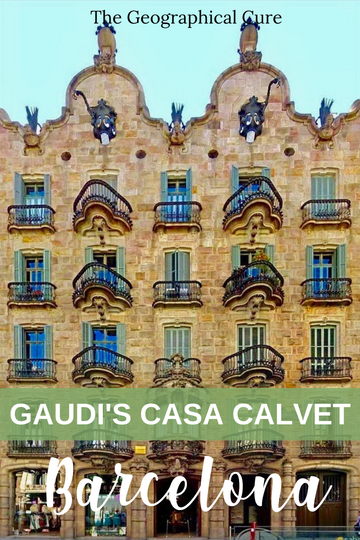Casa Calvet is the neglected stepchild of Gaudí architecture in Barcelona. It’s not as curvy, crazy, or whimsically colorful. And so it’s largely ignored.
But it shouldn’t be. It’s a hidden gem among the other modernist standouts in nearby Passage de Gràcia. And a visit is essential to a full understanding of Gaudí’s more famous UNESCO buildings in Barcelona.
Built between 1898-99, Casa Calvet was commissioned by Pere Calvet, a textile manufacturer. As was common, Calvet set up his business on the ground floor and lived in the upper floors.
Casa Calvet lies in the Eixample district, one of the nicest neighborhoods in Barcelona. In 1900, the Barcelona City Council voted Casa Calvet the best building of the year — the only time Gaudí won such an honor.
The City Council conveniently overlooked the fact that Casa Calvet’s gabled rooftop design was taller than municipal ordinances permitted. It caved when Gaudí complained that he’d sabotage the building himself, if he couldn’t have the facade he envisioned.
The Baroque building is probably the most conventional of Gaudí’s works. Casa Calvet had to be squeezed between older structures and fit into a tony neighborhood.
The sandstone facade has curved double gables crowned with iron crosses. The sandstone was quarried from nearby Montjuïc. There are three sculpted heads at the top: Sant Pere Màrtir Calvet i Carbonell (the owner’s father) and the two patron saints of Vilassar, Andreu Calvet’s home town.
The rear facade is where Gaudí made his mark. Lending a decorative focus to the rear facades was important to Gaudí, as we see from his later work on Casa Battló and Casa Milà. You can’t see it from the street, but it has some elaborate floral designs.
But the building’s ornamentation is classic Gaudí. It has bulging and curved balconies, that presage the mask-like balconies on Casa Battló. The wrought iron is highly stylized and similar to La Pedrera’s twisting “seaweed” look.
Gaudí incorporated many mythological and natural symbols into Casa Calvet. The entrance gallery at the ground level is marked with a large C, a shield of Catalonia, and a cypress that is a symbol of hospitality.
At the top of the facade is the inscription “Any 1899,” the date the home was completed.
In the doorway, there’s original wrought iron door knockers in the form of a Greek cross. The knocker strikes against a figure of a bed bug, in an allegory of faith crushing sin. There’s also a quirky nod to Calvet’s obsession with mushrooms, which he collected. And the columns flanking the door appear like cotton bobbins, a nod to Calvet’s profession.
The building has a luxurious entry hall and staircase. Gaudí designed the Calvet’s furniture as well — office chairs, desks, coat racks, etc. They’re all rendered in his characteristic organic and ergonomic forms. The furniture is now on display at the House Museum in Gaudí’s Park Güell.
Sadly, Casa Calvet is privately owned. It’s not open to the public.
If you’re lucky, you’ll catch a glimpse of the interior when the porter opens the door and you’ll see the outlandish original lift and Gaudí’s hand painted invocations to the Virgin Mary. To the right of the private door is the entrance to the elegant restaurant, Casa Calvet Restaurant.
Booking a dinner there is a sneaky way to experience Casa Calvet. Perhaps after you’ve toured all Gaudi’s famous buildings in Barcelona and your mind is overflowing with Gaudi trivia.
I can’t vouch for the food myself, but it seems to get pretty good reviews and has a creative Mediterranean menu. It’s quite pricey.
Practical Information for Visiting Gaudi’s Casa Calvet:
Address: Carrer de Casp 48
Note: Casa Calvet is a private residence. You can only take pictures of the exterior.
Metro: Metro: L4 L1 Urquinaona
Casa Calvet Restaurant Hours: Mon–Sat: 1:00 pm to 11:00 pm
You may enjoy these other travel guides and resources for Barcelona:
• 1 day itinerary for Barcelona
• 3 day itinerary for Barcelona
• Architecture Lover’s Guide to Eixample
If you liked it, pin it for later.

